This Seedless Fig Jam is an easy way to preserve figs that is not only delectable spread on toast or used to make sweet treats, but equally great in savoury dishes, especially with cheese. The small batch recipe can easily be scaled up if needed and by sieving out the seeds and skin, the texture is smooth and delicious.

This post may contain affiliate links. Please refer to my Disclosures Page for more details.
I have a fig tree in my conservatory but I’ll be honest, it isn’t very fruitful – quite literally. So I did have to go and buy figs to make this jam. But after the roaring success of my Fresh Fig Chutney and the fact that one festive season totally depleted my supplies, I thought a jam would be great to try.
I wasn’t wrong either and I’ve been eating this fig jam in a very similar way to how I ate the chutney – with cheese, mostly brie. I find fig jam to be vaguely similar in flavour to membrillo/quince cheese although it is a little sweeter and is obviously much softer set.
Like with all my jam recipes, I’ve written this to make a small batch of jam. Small batches are easy to multiply and make into larger batches (for example if you are better at growing figs than me and have an actual glut).
By writing and making recipes that make a smaller quantity of jam, I find that I can make, store and eat a wider variety of flavours than if I just make massive batches. Plus you only need a regular large saucepan to make a smaller batch – no need for a proper jam pan or big stock pot.
Smooth & Seedless Jam Recipes
Here you’ll find all of my fabulous jam recipes in one easy place. With no pesky pips, my recipes are all written to make small batches but can easily be scaled up to make larger quantities.
Featuring mixed berry, plum, blueberry, blackberry, strawberry, and raspberry, fig and dark cherry jams plus some ideas how to use it.

How to Serve This Easy Fig Jam
As always, I recommend storing any open jars of jam in the fridge but any jam is best served at room temperature. Flavours can otherwise be dulled plus you’ll make your toast cold!
If you’re using to include in a bake or dessert like this Microwave Jam Sponge Pudding or using as a layer in a Trifle then the temperature really doesn’t matter.
Other sweet ways to serve include:
- Spreading on Scotch Pancakes or Scones with salted butter and fresh cream.
- Swirling into Creamy Rice Pudding or porridge/oatmeal.
- Top yogurt or fromage frais and add some more fresh figs for a simple dessert.
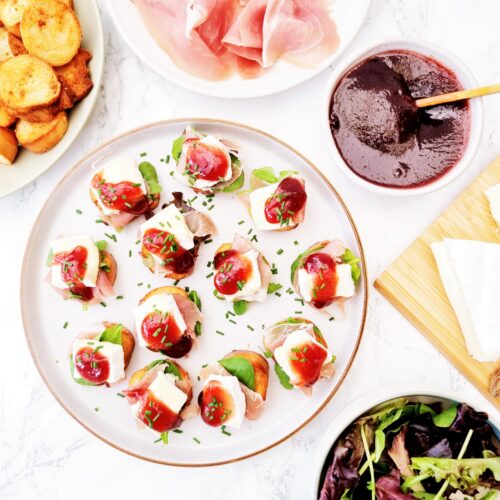
I’ve already mentioned fig jam’s similarity to quince jelly and how I like to eat it in savoury situations. Little canapes with a topping of the fig jam was a roaring success when I made them for the photos on this page.
I air fried slices of a couple of bagels with a generous drizzle of olive oil. Added some pepper salad leaves, a chunk of ripe brie and some prosciutto before topping with the jam. Everything about this little snack was perfect and I highly recommend giving it a go – impressive and delicious with very little effort involved.
For more savoury options try:
- Adding a smear to Bacon & Cheese Wraps or Cheese & Onion Rolls before adding the cheese.
- Glazing a baked or boiled ham or any of my Air Fried Pork Recipes – the tenderloin would be especially delicious.
- Switching it for the honey in this Hot Honey Butter Garlic Sauce to add an extra fruity kick.
- Using instead of the maple syrup in my Baked Camembert with Garlic, Maple & Thyme recipe.

Seedless Fig Jam Ingredients
Figs
The variety of fig you use for this recipe doesn’t matter as long as they’re ripe – not green.
As is quite common in the UK, I grow the Brown Turkey variety but I don’t really get many figs from my small tree. Figs tend to be in prime season in late summer but they grow well for at least half the year.
Turkish grown figs are the most common to buy in the UK – I love them as they do tend to be plump and juicy. Although they are best in late summer/early autumn, like most fruits nowadays, they are available to buy year round.
I do not recommend using is dried figs.
I’ve specified ripe figs in the recipe because the flavour is less pronounced in under-ripe figs. You can use them but ripe and yielding is preferable.
I have specified a weight of figs rather than a quantity. Figs are not all created equal. The ones from my tree can be wildly different sizes. And the kind that I buy pre-packaged from the supermarket tend to be quite small although much bigger and beautiful looking in peak season.
I’m not lucky enough to have a great Turkish deli near my house here but when I was in London I would always head to the deli for fresh figs – if you have this option, I would highly recommend it.
Sugar
You just need regular white sugar to make jam. You don’t need expensive specialist jam sugar that contains added pectin – it isn’t necessary for this recipe. All fruit contains natural pectin and we’re going to help it along with lemon juice too.
It make no difference whether you use regular or caster/superfine sugar since it will melt in the pan. I personally use granulated sugar as it is a more economical choice. Save the pricier caster sugar for when it’s qualities are needed.
Avoid using brown sugar or sugar alternatives as they will impart an unusual flavour or texture to the jam, respectively.

Lemon Juice
As I mentioned, the lemon juice will add a little extra pectin to help the fig jam to set. As a bonus, it also adds a bright zing of acidity to cut through a little of the sugar/sweetness and helps to keep the pink fig colour.
I don’t often bother to squeeze a fresh lemon when making jam although of course you can. Bottled lemon juice which I buy and keep in the fridge is what I normally grab and use.
Using too much lemon juice can result in jam becoming overset. For this reason it is important to measure the juice you’re using and try to be fairly accurate about it. If you want to add more actual lemon flavour, you can add some fresh and very finely grated lemon zest instead.

Be Flexible
As I most often do, I’ve kept this jam recipe wholly focussed on the pure fig flavour. That means that it is the perfect base to add your own secondary flavours to if you wish.
Some of the figs can be replaced with another fruit. Fig and plum jam would be a delicious option.
You can add citrus flavours very easily – the zest is easy to incorporate at the very beginning of the process. If you do it then, the flavour will infuse into the figs but the little bits of actual zest will be sieved out.
Alcohol is a common addition to jam, you just need to think about the flavours that will pair well with fig and not overpower the flavour. Cointreau/triple sec is one of my favourite spirits to cook with – and orange will go great with the fig flavour just like in my chutney recipe.
Many of the fig preserves that are sold or that you can find recipes for are spiced with warming winter spices. Cinnamon is a very common flavour pairing and ginger is my favourite. You can also add spice mixes like pumpkin pie spice or British mixed spice.

Vegetarian or Vegan Smooth Fig Jam
This fig jam recipe is vegetarian as written.
Whether there is such a thing as vegan fig jam is more open to debate as many vegans won’t eat figs because a tiny fig wasp pollinates each fig and is then absorbed by the fig.
I think there are some rather sensible arguments for that not making figs an animal product and there are varieties of figs that aren’t pollinated in this way. So if you’re making this for or planning on serving it to a vegan, I’d check with them if they eat figs first.
Make Allergy Friendly Fig Jam
This recipe is free from egg, dairy, gluten and nuts.
Please note that this recipe may contain other allergens not referred to above and any variations suggested have not been tested unless otherwise stated. For more information regarding any dietary information provided on this website, please refer to my Nutritional Disclaimer.

Equipment Notes for Seedless Fig Jam
Jam doesn’t require any specialist equipment. The most important thing is to have a good sized pan. This recipe using just over a pound of fruit (500g) makes a fairly small amount of the finished product but you still need to use a good large saucepan.
You might think that I’m being excessive when you first see the amount of fruit in the pan but it bubbles up so much when boiling, you’ll soon understand why. This fig jam is especially volatile.
There are a few things that will help make your jam making easier although they’re not essential. A thermometer is one of them. It turns out that I own quite a selection and they are all suitable. My laser thermometer is mess free and fun to use.
My meat thermometer posed a little more peril as I needed to hold it in the jam until it registered the temperature. And my old fashioned sugar thermometer just happily sat in the pan the whole time. But it was harder to wash up!
And don’t forget something the store the jam in. I love my super cute quilted jam jar set. But you can simply use old jam jars that you’ve thoroughly cleaned.
A comprehensive list of the equipment used to make this recipe is included in the main recipe card below. Click on any item to see an example. There are no hard and fast rules so many items can be sensibly substituted to achieve the same results.

Get Ahead
You can make fig jam up to a year in advance if you prepare your jars properly. But you only really need to make it the day before you want to eat it.
You should ideally give the jam 24 hours to cool but you can speed it up by putting it in the fridge for 12 to 16 hours.

How to Sterilise Jars and Preserve/Can Jam
There is a whole world of variations and advice for how you should prepare your jars and deal with the jars once they’re sealed. They vary from person to person and country to country.
Here in the UK we largely make sure that the jars are properly sterilised, fill the jars with the hot jam, seal them and that’s that. In the US it is almost a given that the jars will then be “processed” to complete the “canning” process. I have purposely provided no links here – if you’d like to learn more about canning, Google is your friend.
There are a lot of strong feelings about this in the “jam community” (yes there is one) which I have no interest in being drawn into. All I know is that UK cooks have been making jam for a very long time without any issues. Therefore I am more than happy to follow the UK process for my jams.
Jar Sterilisation Options
There are several ways that you can sterilise your jam jars.
- Run the jars and lids through a hot wash in the dishwasher.
- Bake the jars and lids in the oven on a baking tray.
- Microwave the jars and boil the lids in water.
- Boil the jars and lids in water.
Whichever method you choose the only important thing is to make sure that the jars and lids are left to dry without being touched. And that you do not under any circumstances touch the inside of the jars or lids as this can contaminate them and undo your sterilisation. Tongs are your friend.
For the record, I usually use the dishwasher method.
How to Tell if the Jar is Sealed
It is essential to add the lid to the hot jars filled with the hot jam straight away. As the jam and jar cool, a vacuum is created in the jar and the lid will be pulled downwards. To help this, I often turn my jars upside down to cool.
This means that when you press the lid, it doesn’t move or pop. When you open a jar of properly sealed jam the lid will then pop. And an opened or not properly sealed jar will pop when you press it.
If your jars don’t seal properly, you can either keep the jar in the fridge and eat it relatively quickly or go though a canning process to seal them. The choice is yours.

Seedless Fig Jam Tips & A Warning
I always include a warning to be very careful not to touch the hot fruit or hot jam, however tempting it feels because it will be silly hot and burn you. But this jam requires an extra severe warning as the boiling jam spits everywhere and is rather volcanic. It happens because of the density of the fruit.
- Make sure to use a really large pan.
- Feel free to add a lid to the pan inbetween stirs.
- Use a decently long spatula or wooden spoon.
- You may want to consider using an oven glove for extra safety.
- Don’t cook this one with kids or anyone that doesn’t have a decent amount of inherent common sense.
If you don’t need to keep your jam for any length of time, you can skip the jar stage and use any old container and keep your jam in the fridge.
If you are using a thermometer, you can simply rely on the jam hitting temperature and not worry about doing the wrinkle test on a cold plate. I like to take a belt and braces approach so I use both testing methods. But you can just use one or the other.
If you aren’t bothered about the jam being super smooth, skip the blending and sieving stage but give the figs a good mash down with the spatula while they are cooking.

Don’t forget to let me know in the comments if you try making this recipe – I want to know what you think and if you made any substitutions, how did it turn out?
Still Have Questions?
Simple! Just contact me and I will do my best to help as quickly as I am able. Head over to my Contact Me page, any of my social media channels or post a comment at the bottom of this page and I’ll see what I can do.
Pin Seedless Fig Jam For Later
Hit one of the share buttons to save this page to your Pinterest boards so you can come back and find it at anytime!

Keep Up to Date
Make sure you SUBSCRIBE to my newsletter and avoid missing out on any of my newest and bonus content. Don’t worry, I promise not to spam you or bombard you too often. Plus you’ll receive a copy of my FREE 7 Day International Meal Plan!
Also please don’t forget to follow me over on my social media channels over at Facebook, Twitter, Instagram and Pinterest. I love to interact with my followers and I’d love you to share my content with your friends too.
The Recipe
Seedless Fig Jam (Small Batch Recipe)
Equipment
Ingredients
- 500 g Ripe Figs
- 350 g Sugar
- 2 tsp Lemon Juice
- 200 ml Water
Instructions
- Pop two ceramic or china plates into the freezer.
- Prepare and sterilise your jars or container for your jam. How you chose to do this is up to you. Further details are provided in this recipe post.

- Rinse and dry just slightly more than 500g Fresh Figs.
- Use a sharp knife to slice off the top of the fig. Slice enough to reveal the soft flesh inside. Discard the tops then cut the rest of the figs into small pieces.

- Put the cut figs into a large saucepan along with 350g Sugar and 2 tsp Lemon Juice.

- Cook over a medium high heat until the figs have fully softened and the sugar is fully dissolved. You will want to keep stirring regularly while this is happening.

- Tip the cooked figs into a heatproof jug or bowl. Make sure it is big enough to prevent anything from splattering out when being blended. You should also be very careful when doing this as the fruit will be very hot.

- Blitz the fruit really well until as smooth as possible. I prefer to use a stick blender but you can use any blender or food processor.

- Sieve the puree back into the saucepan. Use a spatula to push the pulp through the sieve.

- This will take a few minutes but have patience as this is how we get a smooth jam. You should be left with a fairly dry bit of seeds left in the sieve. Don’t forget to wipe the underside of the sieve into the pan.

- Put the pan on a medium heat, and add 200ml Water.
- Stir well as the mixture warms and allow the jam to come up to a rolling boil.

- Allow the jam to boil for 9-10 minutes or until the jam reaches the 105c or 225f. You can give it a gentle stir and scrape of the sides and bottom every minute or so to keep things even.

- Take the jam off the heat and take one of your very cold plates out of the freezer. Use a small spoon to dollop a small amount of jam onto the plate. Leave it for 1 minute and then push the jam towards the centre of the dollop. If you get wrinkles, the jam is ready.

- If you don’t, put the pan back on the heat for another minute.

- Repeat the cold plate test as many times as is needed. Make sure to clean and put your first plate back in the freezer in case you need it again.

- Carefully pour the jam into your prepared jars or container.

- Seal and leave to cool or continue the canning process if you have chosen to.













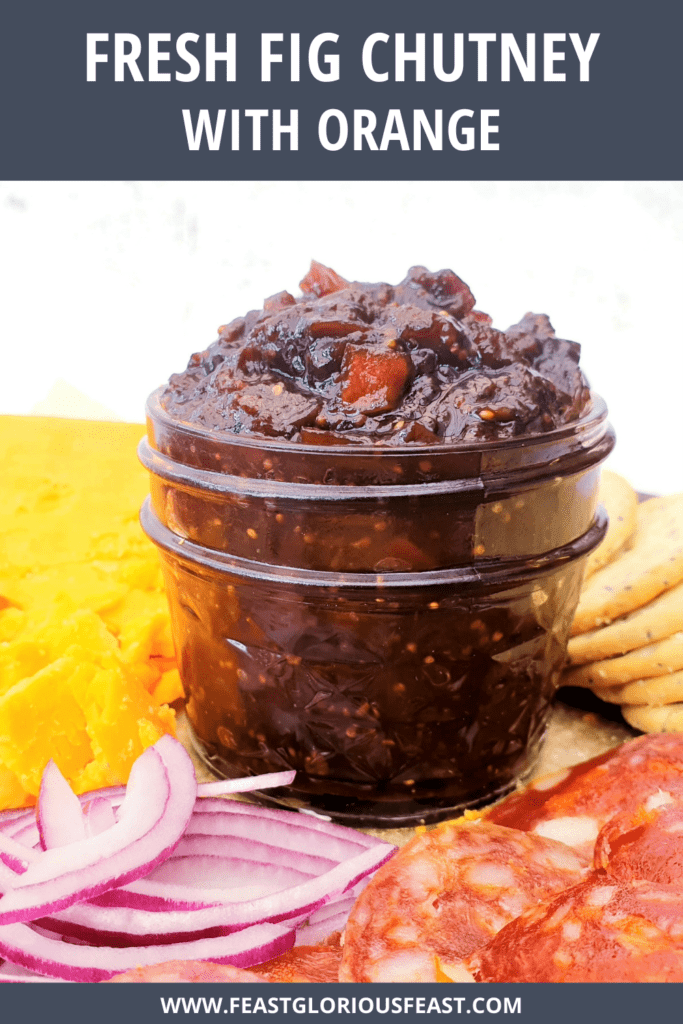
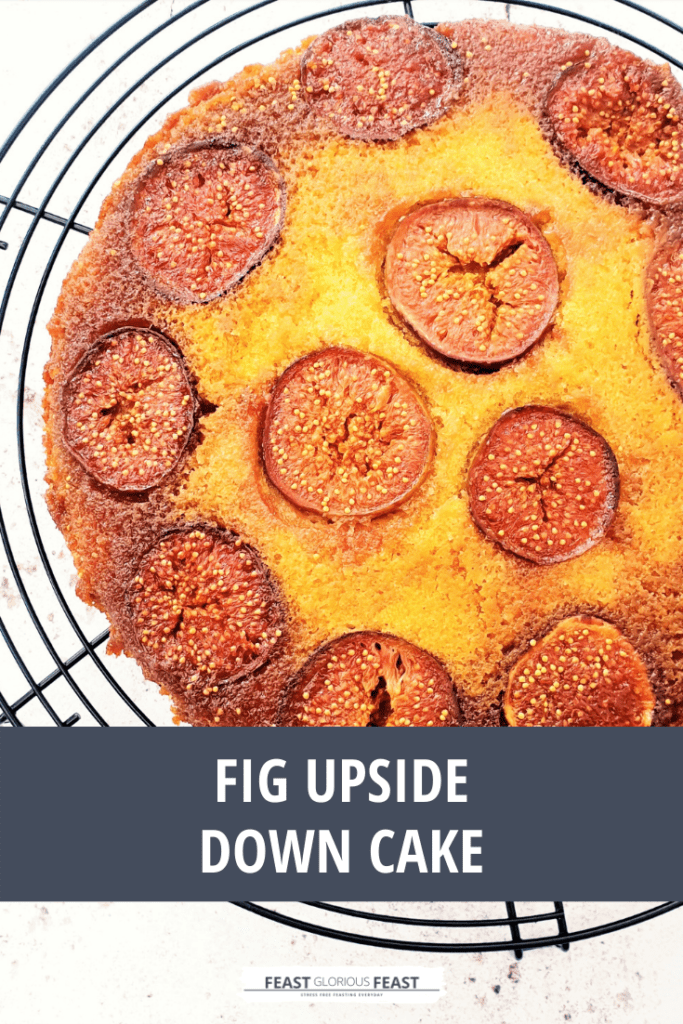
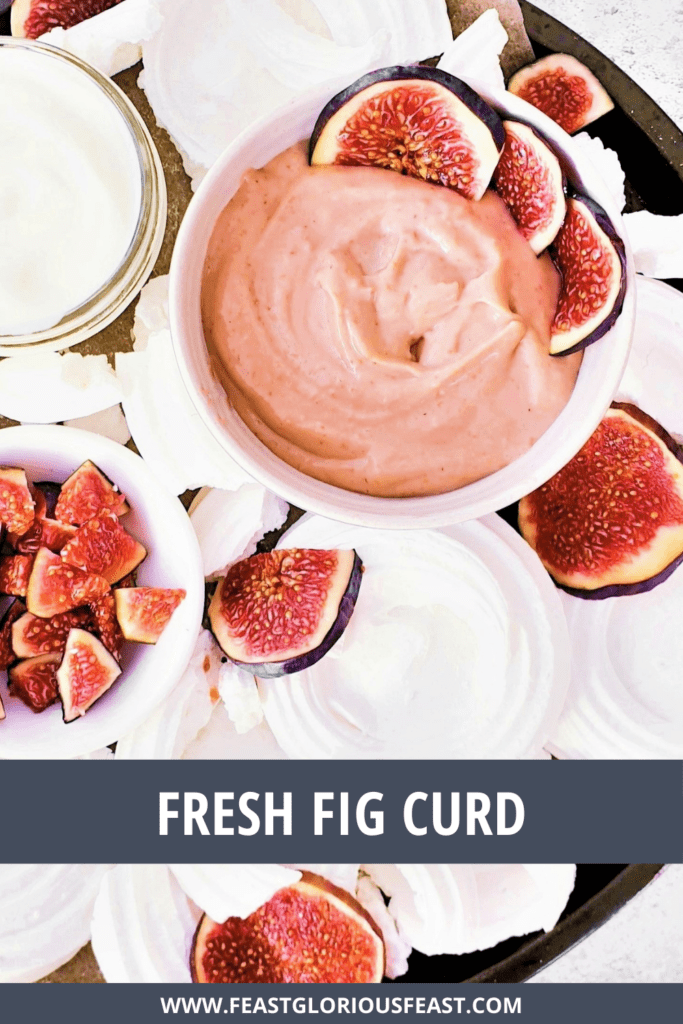
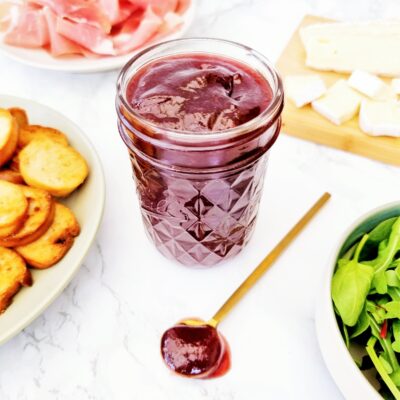














Susan says
Wish warnings were given next to steps of recipe. A large stockpot would be better to use for making fig jam. A candy thermometer is very hard to read with splatters all over it. Clean each tool /bowls stove area immediately after use ( soap and warm water and Lysol cleaner works good). The fig mix after cook with sugar, blended then liquified in a blender 1 and 1/2 min. got rid of texture of seeds. Will rectify recipe and try again because fig jam was delicious .
Chloe says
I wish people would read the post mate but apparently we can’t have it all.
Equipment – “The most important thing is to have a good sized pan. This recipe using just over a pound of fruit (500g) makes a fairly small amount of the finished product but you still need to use a good large saucepan. You might think that I’m being excessive when you first see the amount of fruit in the pan but it bubbles up so much when boiling, you’ll soon understand why. This fig jam is especially volatile.”
Tips and Warning – “I always include a warning to be very careful not to touch the hot fruit or hot jam, however tempting it feels because it will be silly hot and burn you. But this jam requires an extra severe warning as the boiling jam spits everywhere and is rather volcanic. It happens because of the density of the fruit. – Make sure to use a really large pan. – Feel free to add a lid to the pan inbetween stirs. – Use a decently long spatula or wooden spoon. – You may want to consider using an oven glove for extra safety. – Don’t cook this one with kids or anyone that doesn’t have a decent amount of inherent common sense.” <-- this section is literally highlighted in red. Step 7 - "Tip the cooked figs into a heatproof jug or bowl. Make sure it is big enough to prevent anything from splattering out when being blended. You should also be very careful when doing this as the fruit will be very hot." Other than coming round to your house to do a health and safety assessment, I really don't know what else you actually want me to do. As for including cleaning instructions in the recipe...are you for real?
Sally says
I was tempted by some reduced figs at the supermarket so thought I’d give this a go. It’s really delicious and makes the perfect amount.
Lesley says
I love the flavour of figs so this jam is right up my street. I like that’s it’s a small batch recipe too.